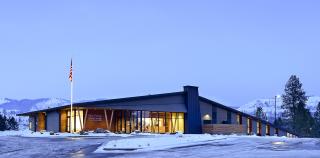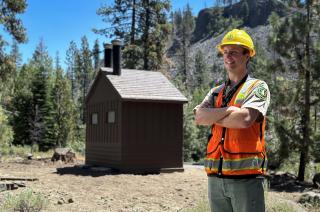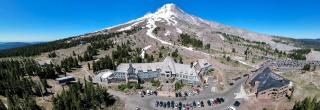Facilities
Many types of buildings and other structures are located on Forest Service land like fire stations, visitor centers, office buildings, and restrooms. However, the agency also maintains and manages many other types of facilities such as research laboratories, houses, dormitories, nurseries, and communication sites. Most of the agency’s 40,000 buildings totaling almost 30 million square feet of space are maintained and managed by the Forest Service, however some buildings are leased through the General Services Administration (GSA) or from other entities. Some facilities located on national forests are also operated under special use permits.
The agency also manages a variety of recreational facilities such as visitor centers, campgrounds, boat ramps and fishing docks for more than 155 million visitors who recreate on national forests and grasslands each year. In addition to traditional recreation sites, some Forest Service buildings such as cabins or converted fire lookouts may be available for public use or rental. Please check Recreation.gov or contact your local Forest Service office for questions related to recreation use on your national forests and grasslands.
Water and Wastewater
The Forest Service operates over 4600 drinking water systems. These range from a simple hydrant providing water at a backcountry campground, to complex systems which serve large campgrounds, office complexes, and government housing facilities. The agency also operates over 4700 wastewater systems which include septic tanks and drain fields as well as wastewater treatment plants. The agency also maintains and manages over 17,000 toilet buildings to serve the public. Many of these toilet buildings are waterless, self-contained vault which utilize the Sweet Smelling Toilet technology to enhance the visitor experience. All water and wastewater systems are managed in compliance with applicable health and safety regulations.

Communication Towers and Sites
The Forest Service maintains and manages over 1,800 communication sites nationwide. A communication site is a site established and operated to provide telecommunications for Forest Service administrative use. These facilities also play an integral part of the nation’s telecommunication infrastructure by additionally supporting cellular, television, radio, broadband and emergency services to both urban and rural areas through Special Use Permits that are authorized and administered by the Forest Service.
A communication site may include telecommunication towers specifically designed to support equipment such as microwave dishes or antennas, power and fuel systems, helipads and communication shelters manufactured to house various radio and telecommunication equipment. Forest Service communication sites can be located at Supervisor’s Offices, Ranger Stations or at remote locations strategically chosen to provide optimal radio frequency coverage.

Sustainability
The Forest Service is committed to sustainability in building and facilities management and complies with the “Guiding Principles for Sustainable Federal Buildings”, issued by the Council on Environmental Quality.
The “Guiding Principles” address the following six sustainable principles for new construction and modernization, as well as existing buildings:
Employ integrated design principles
Optimize energy performance
Protect and conserve water
Enhance the indoor environmental quality
Reduce the environmental impact of materials
Assess and consider building resilience
An example of sustainable building practices at work can be found in the Supervisor’s Office for the Nez Perce-Clearwater National Forest, located in Kamiah, Idaho. The building is constructed from glue-laminated timber (glulam) and bio preferred cross-laminated timber. The estimated total potential carbon benefit of this project is 707 metric tons of carbon dioxide, which is equivalent to keeping 149 cars off the road for a year.

Accessibility
Newly constructed and renovated facilities must be accessible in accordance with the Architectural Barriers Act (ABA). Because many Forest Service facilities were constructed before the passage of the ABA, and because accessibility standards change over time, some facilities may not be fully accessible according to today’s standards. These facilities are covered by a transition plan, which helps guide the agency in making improvements to reduce barriers to accessibility. Some projects funded by the Great American Outdoors Act are intended to increase the accessibility of agency facilities to all visitors.

Historic Structures
Forest Service engineers work closely with heritage program staff in the management of the agency’s older structures. Many Forest Service buildings are eligible for listing on the National Register of Historic Places. One such example is Timberline Lodge on the Mt. Hood National Forest in northern Oregon. This National Historic Landmark, constructed in 1937, was awarded funding through the Great American Outdoors Act to renovate the boiler system for the main and day lodge. Careful planning and coordination between engineers and heritage program staff is required to ensure that any maintenance or renovation projects do not impact the historical integrity of agency facilities.

